A Study: Branding Impact on Decathlon India's Organizational Growth
VerifiedAdded on 2021/06/22
|13
|3785
|91
Report
AI Summary
This report presents a study on the impact of branding on organizational growth and development in the sportswear industry, specifically focusing on Decathlon India. The research explores the branding process and strategies employed by Decathlon, examining their influence on the company's growth and market position within the Indian sportswear market. The report investigates factors influencing brand perception, brand loyalty, and the effectiveness of Decathlon's branding strategies compared to international markets. The methodology includes a descriptive research design, quantitative research strategy, and data collection through surveys and interviews with Decathlon India employees. The study aims to identify the company's branding strategies, understand the impact of branding on organizational development, and assess the differences in branding approaches between the Indian and international markets. The report provides a comprehensive overview of the Indian sportswear market and the impact of branding within it, offering valuable insights into Decathlon's success and branding practices.
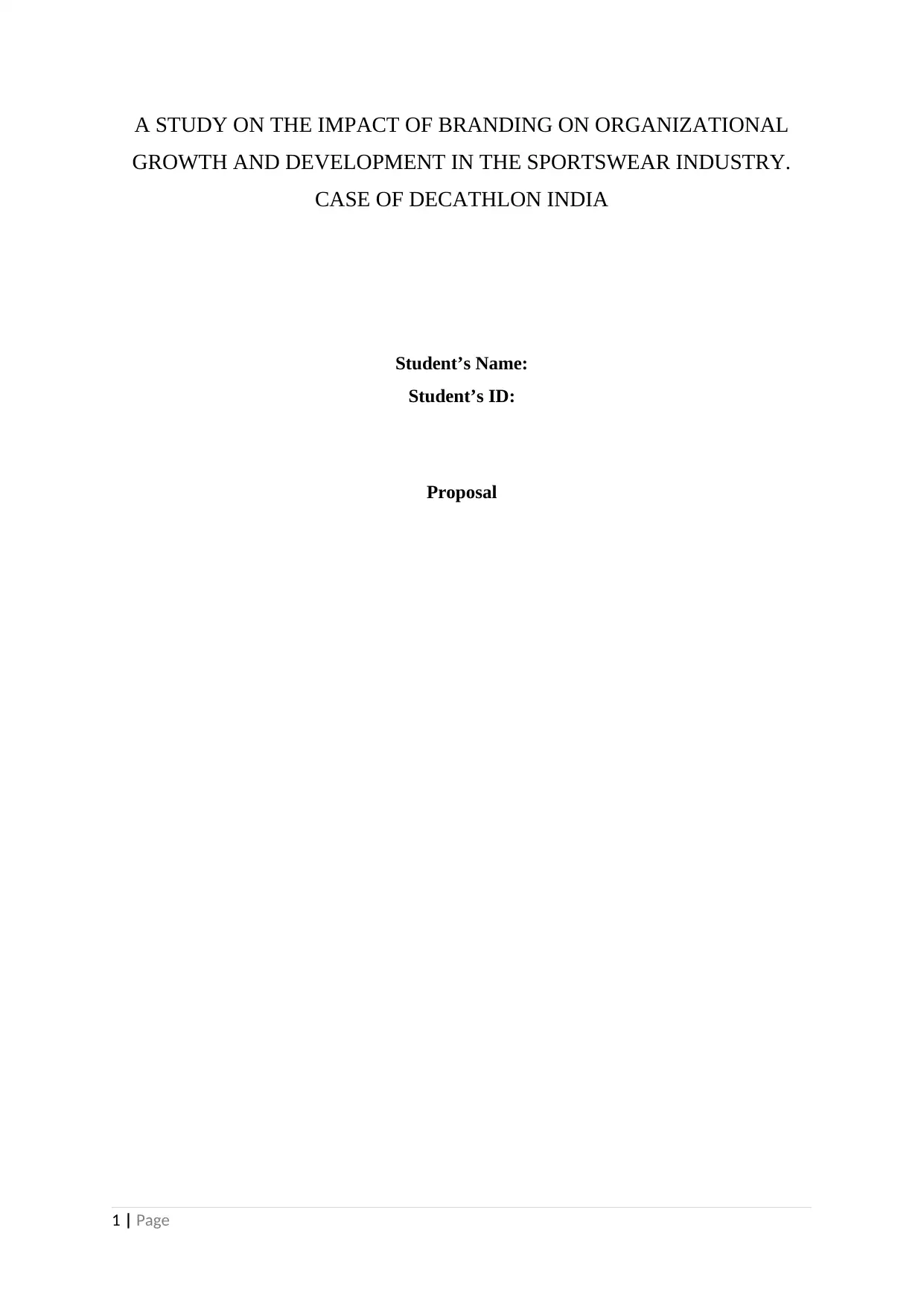
A STUDY ON THE IMPACT OF BRANDING ON ORGANIZATIONAL
GROWTH AND DEVELOPMENT IN THE SPORTSWEAR INDUSTRY.
CASE OF DECATHLON INDIA
Student’s Name:
Student’s ID:
Proposal
1 | Page
GROWTH AND DEVELOPMENT IN THE SPORTSWEAR INDUSTRY.
CASE OF DECATHLON INDIA
Student’s Name:
Student’s ID:
Proposal
1 | Page
Paraphrase This Document
Need a fresh take? Get an instant paraphrase of this document with our AI Paraphraser
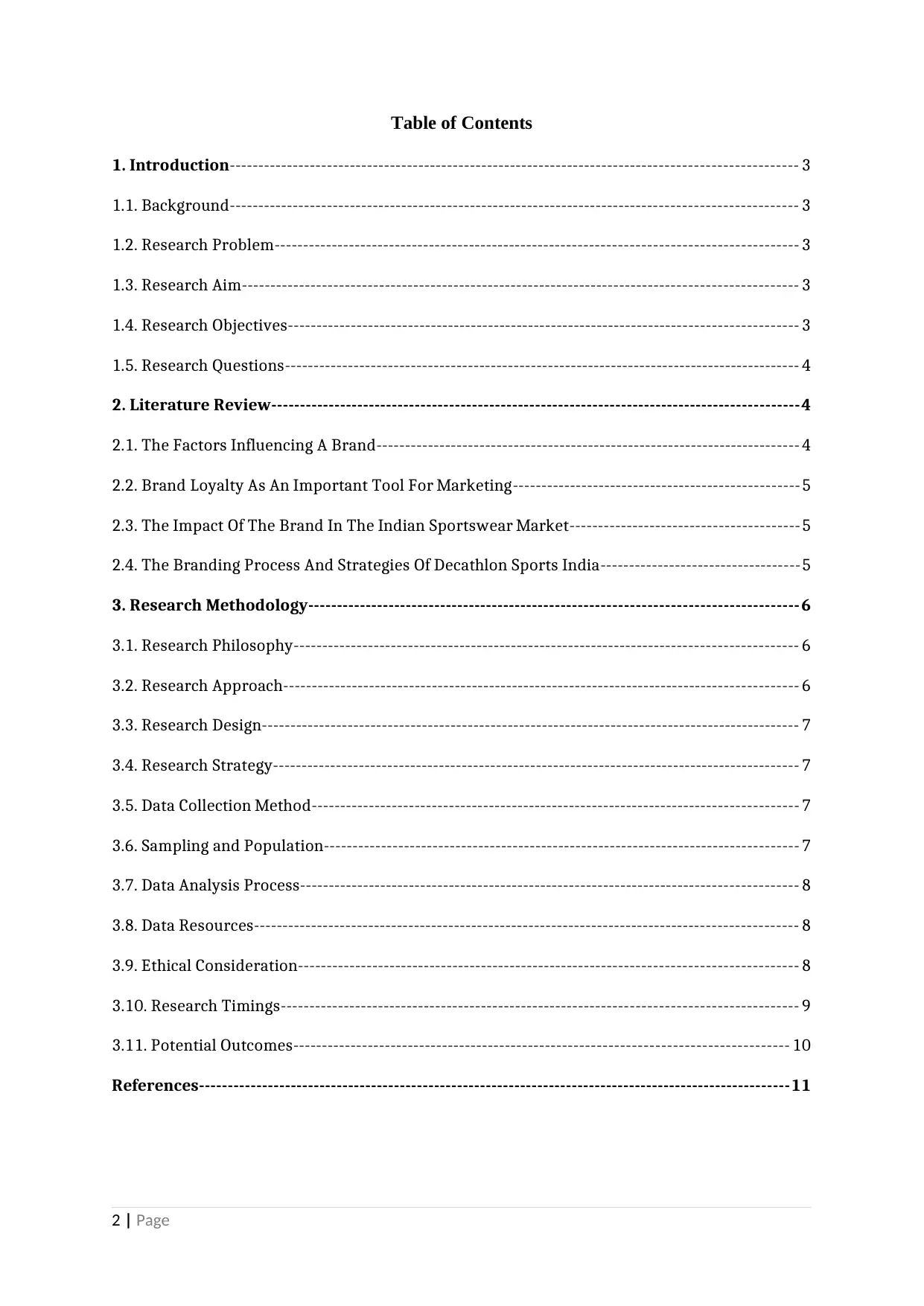
Table of Contents
1. Introduction--------------------------------------------------------------------------------------------------- 3
1.1. Background--------------------------------------------------------------------------------------------------- 3
1.2. Research Problem------------------------------------------------------------------------------------------- 3
1.3. Research Aim------------------------------------------------------------------------------------------------- 3
1.4. Research Objectives----------------------------------------------------------------------------------------- 3
1.5. Research Questions------------------------------------------------------------------------------------------ 4
2. Literature Review--------------------------------------------------------------------------------------------4
2.1. The Factors Influencing A Brand-------------------------------------------------------------------------- 4
2.2. Brand Loyalty As An Important Tool For Marketing--------------------------------------------------5
2.3. The Impact Of The Brand In The Indian Sportswear Market----------------------------------------5
2.4. The Branding Process And Strategies Of Decathlon Sports India-----------------------------------5
3. Research Methodology-------------------------------------------------------------------------------------6
3.1. Research Philosophy---------------------------------------------------------------------------------------- 6
3.2. Research Approach------------------------------------------------------------------------------------------ 6
3.3. Research Design---------------------------------------------------------------------------------------------- 7
3.4. Research Strategy-------------------------------------------------------------------------------------------- 7
3.5. Data Collection Method------------------------------------------------------------------------------------- 7
3.6. Sampling and Population----------------------------------------------------------------------------------- 7
3.7. Data Analysis Process--------------------------------------------------------------------------------------- 8
3.8. Data Resources----------------------------------------------------------------------------------------------- 8
3.9. Ethical Consideration--------------------------------------------------------------------------------------- 8
3.10. Research Timings------------------------------------------------------------------------------------------ 9
3.11. Potential Outcomes-------------------------------------------------------------------------------------- 10
References-------------------------------------------------------------------------------------------------------11
2 | Page
1. Introduction--------------------------------------------------------------------------------------------------- 3
1.1. Background--------------------------------------------------------------------------------------------------- 3
1.2. Research Problem------------------------------------------------------------------------------------------- 3
1.3. Research Aim------------------------------------------------------------------------------------------------- 3
1.4. Research Objectives----------------------------------------------------------------------------------------- 3
1.5. Research Questions------------------------------------------------------------------------------------------ 4
2. Literature Review--------------------------------------------------------------------------------------------4
2.1. The Factors Influencing A Brand-------------------------------------------------------------------------- 4
2.2. Brand Loyalty As An Important Tool For Marketing--------------------------------------------------5
2.3. The Impact Of The Brand In The Indian Sportswear Market----------------------------------------5
2.4. The Branding Process And Strategies Of Decathlon Sports India-----------------------------------5
3. Research Methodology-------------------------------------------------------------------------------------6
3.1. Research Philosophy---------------------------------------------------------------------------------------- 6
3.2. Research Approach------------------------------------------------------------------------------------------ 6
3.3. Research Design---------------------------------------------------------------------------------------------- 7
3.4. Research Strategy-------------------------------------------------------------------------------------------- 7
3.5. Data Collection Method------------------------------------------------------------------------------------- 7
3.6. Sampling and Population----------------------------------------------------------------------------------- 7
3.7. Data Analysis Process--------------------------------------------------------------------------------------- 8
3.8. Data Resources----------------------------------------------------------------------------------------------- 8
3.9. Ethical Consideration--------------------------------------------------------------------------------------- 8
3.10. Research Timings------------------------------------------------------------------------------------------ 9
3.11. Potential Outcomes-------------------------------------------------------------------------------------- 10
References-------------------------------------------------------------------------------------------------------11
2 | Page
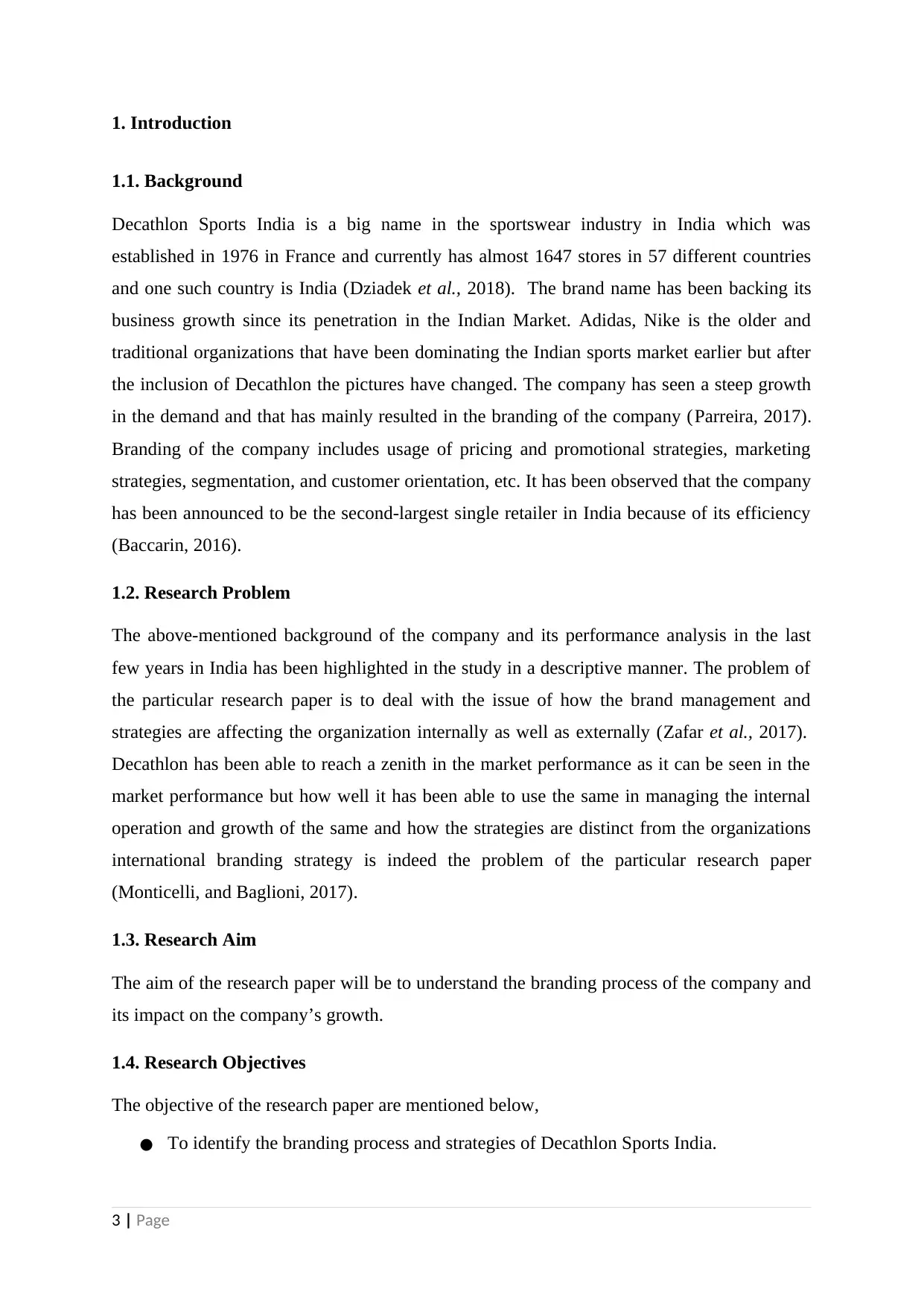
1. Introduction
1.1. Background
Decathlon Sports India is a big name in the sportswear industry in India which was
established in 1976 in France and currently has almost 1647 stores in 57 different countries
and one such country is India (Dziadek et al., 2018). The brand name has been backing its
business growth since its penetration in the Indian Market. Adidas, Nike is the older and
traditional organizations that have been dominating the Indian sports market earlier but after
the inclusion of Decathlon the pictures have changed. The company has seen a steep growth
in the demand and that has mainly resulted in the branding of the company (Parreira, 2017).
Branding of the company includes usage of pricing and promotional strategies, marketing
strategies, segmentation, and customer orientation, etc. It has been observed that the company
has been announced to be the second-largest single retailer in India because of its efficiency
(Baccarin, 2016).
1.2. Research Problem
The above-mentioned background of the company and its performance analysis in the last
few years in India has been highlighted in the study in a descriptive manner. The problem of
the particular research paper is to deal with the issue of how the brand management and
strategies are affecting the organization internally as well as externally (Zafar et al., 2017).
Decathlon has been able to reach a zenith in the market performance as it can be seen in the
market performance but how well it has been able to use the same in managing the internal
operation and growth of the same and how the strategies are distinct from the organizations
international branding strategy is indeed the problem of the particular research paper
(Monticelli, and Baglioni, 2017).
1.3. Research Aim
The aim of the research paper will be to understand the branding process of the company and
its impact on the company’s growth.
1.4. Research Objectives
The objective of the research paper are mentioned below,
● To identify the branding process and strategies of Decathlon Sports India.
3 | Page
1.1. Background
Decathlon Sports India is a big name in the sportswear industry in India which was
established in 1976 in France and currently has almost 1647 stores in 57 different countries
and one such country is India (Dziadek et al., 2018). The brand name has been backing its
business growth since its penetration in the Indian Market. Adidas, Nike is the older and
traditional organizations that have been dominating the Indian sports market earlier but after
the inclusion of Decathlon the pictures have changed. The company has seen a steep growth
in the demand and that has mainly resulted in the branding of the company (Parreira, 2017).
Branding of the company includes usage of pricing and promotional strategies, marketing
strategies, segmentation, and customer orientation, etc. It has been observed that the company
has been announced to be the second-largest single retailer in India because of its efficiency
(Baccarin, 2016).
1.2. Research Problem
The above-mentioned background of the company and its performance analysis in the last
few years in India has been highlighted in the study in a descriptive manner. The problem of
the particular research paper is to deal with the issue of how the brand management and
strategies are affecting the organization internally as well as externally (Zafar et al., 2017).
Decathlon has been able to reach a zenith in the market performance as it can be seen in the
market performance but how well it has been able to use the same in managing the internal
operation and growth of the same and how the strategies are distinct from the organizations
international branding strategy is indeed the problem of the particular research paper
(Monticelli, and Baglioni, 2017).
1.3. Research Aim
The aim of the research paper will be to understand the branding process of the company and
its impact on the company’s growth.
1.4. Research Objectives
The objective of the research paper are mentioned below,
● To identify the branding process and strategies of Decathlon Sports India.
3 | Page
⊘ This is a preview!⊘
Do you want full access?
Subscribe today to unlock all pages.

Trusted by 1+ million students worldwide
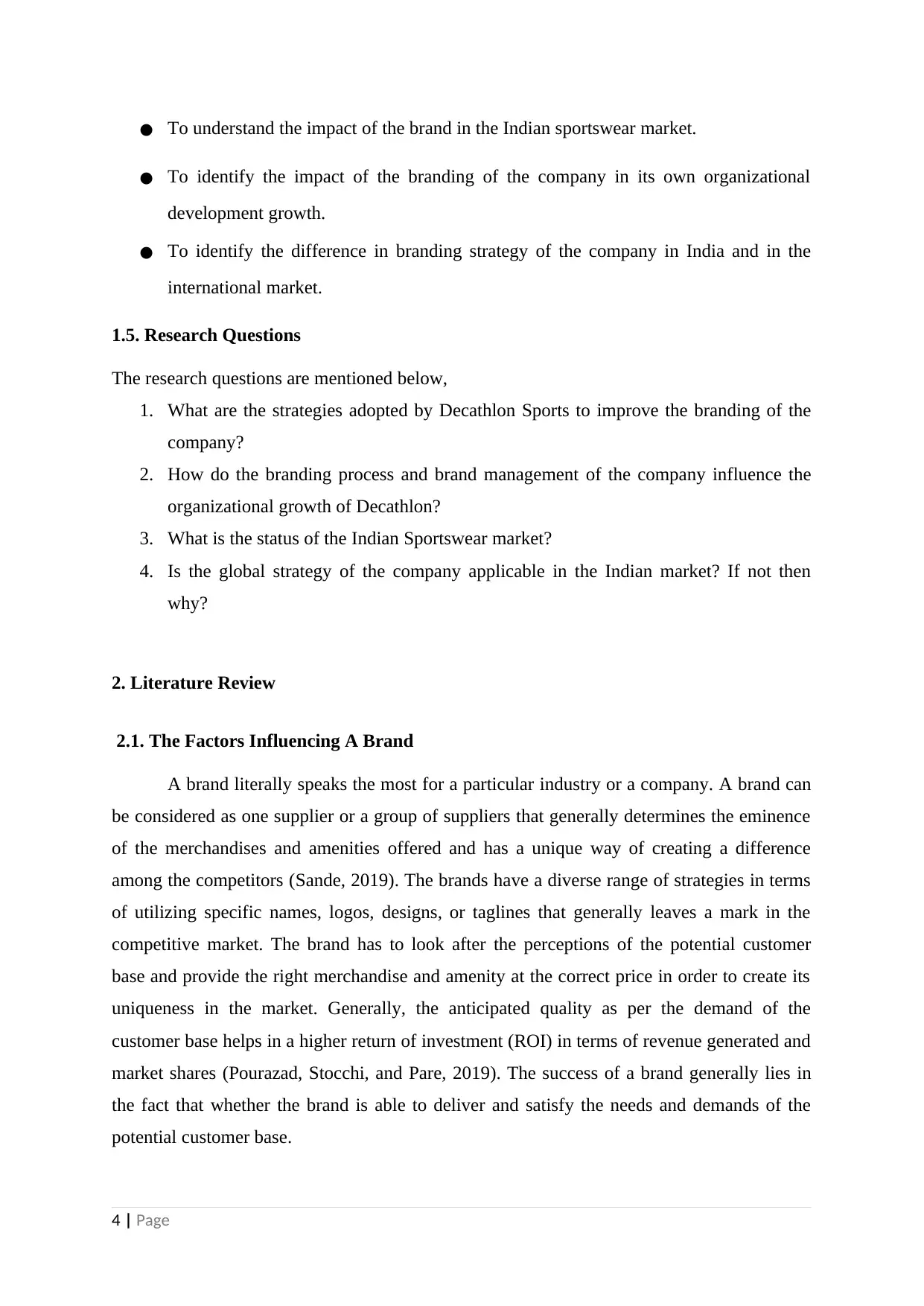
● To understand the impact of the brand in the Indian sportswear market.
● To identify the impact of the branding of the company in its own organizational
development growth.
● To identify the difference in branding strategy of the company in India and in the
international market.
1.5. Research Questions
The research questions are mentioned below,
1. What are the strategies adopted by Decathlon Sports to improve the branding of the
company?
2. How do the branding process and brand management of the company influence the
organizational growth of Decathlon?
3. What is the status of the Indian Sportswear market?
4. Is the global strategy of the company applicable in the Indian market? If not then
why?
2. Literature Review
2.1. The Factors Influencing A Brand
A brand literally speaks the most for a particular industry or a company. A brand can
be considered as one supplier or a group of suppliers that generally determines the eminence
of the merchandises and amenities offered and has a unique way of creating a difference
among the competitors (Sande, 2019). The brands have a diverse range of strategies in terms
of utilizing specific names, logos, designs, or taglines that generally leaves a mark in the
competitive market. The brand has to look after the perceptions of the potential customer
base and provide the right merchandise and amenity at the correct price in order to create its
uniqueness in the market. Generally, the anticipated quality as per the demand of the
customer base helps in a higher return of investment (ROI) in terms of revenue generated and
market shares (Pourazad, Stocchi, and Pare, 2019). The success of a brand generally lies in
the fact that whether the brand is able to deliver and satisfy the needs and demands of the
potential customer base.
4 | Page
● To identify the impact of the branding of the company in its own organizational
development growth.
● To identify the difference in branding strategy of the company in India and in the
international market.
1.5. Research Questions
The research questions are mentioned below,
1. What are the strategies adopted by Decathlon Sports to improve the branding of the
company?
2. How do the branding process and brand management of the company influence the
organizational growth of Decathlon?
3. What is the status of the Indian Sportswear market?
4. Is the global strategy of the company applicable in the Indian market? If not then
why?
2. Literature Review
2.1. The Factors Influencing A Brand
A brand literally speaks the most for a particular industry or a company. A brand can
be considered as one supplier or a group of suppliers that generally determines the eminence
of the merchandises and amenities offered and has a unique way of creating a difference
among the competitors (Sande, 2019). The brands have a diverse range of strategies in terms
of utilizing specific names, logos, designs, or taglines that generally leaves a mark in the
competitive market. The brand has to look after the perceptions of the potential customer
base and provide the right merchandise and amenity at the correct price in order to create its
uniqueness in the market. Generally, the anticipated quality as per the demand of the
customer base helps in a higher return of investment (ROI) in terms of revenue generated and
market shares (Pourazad, Stocchi, and Pare, 2019). The success of a brand generally lies in
the fact that whether the brand is able to deliver and satisfy the needs and demands of the
potential customer base.
4 | Page
Paraphrase This Document
Need a fresh take? Get an instant paraphrase of this document with our AI Paraphraser
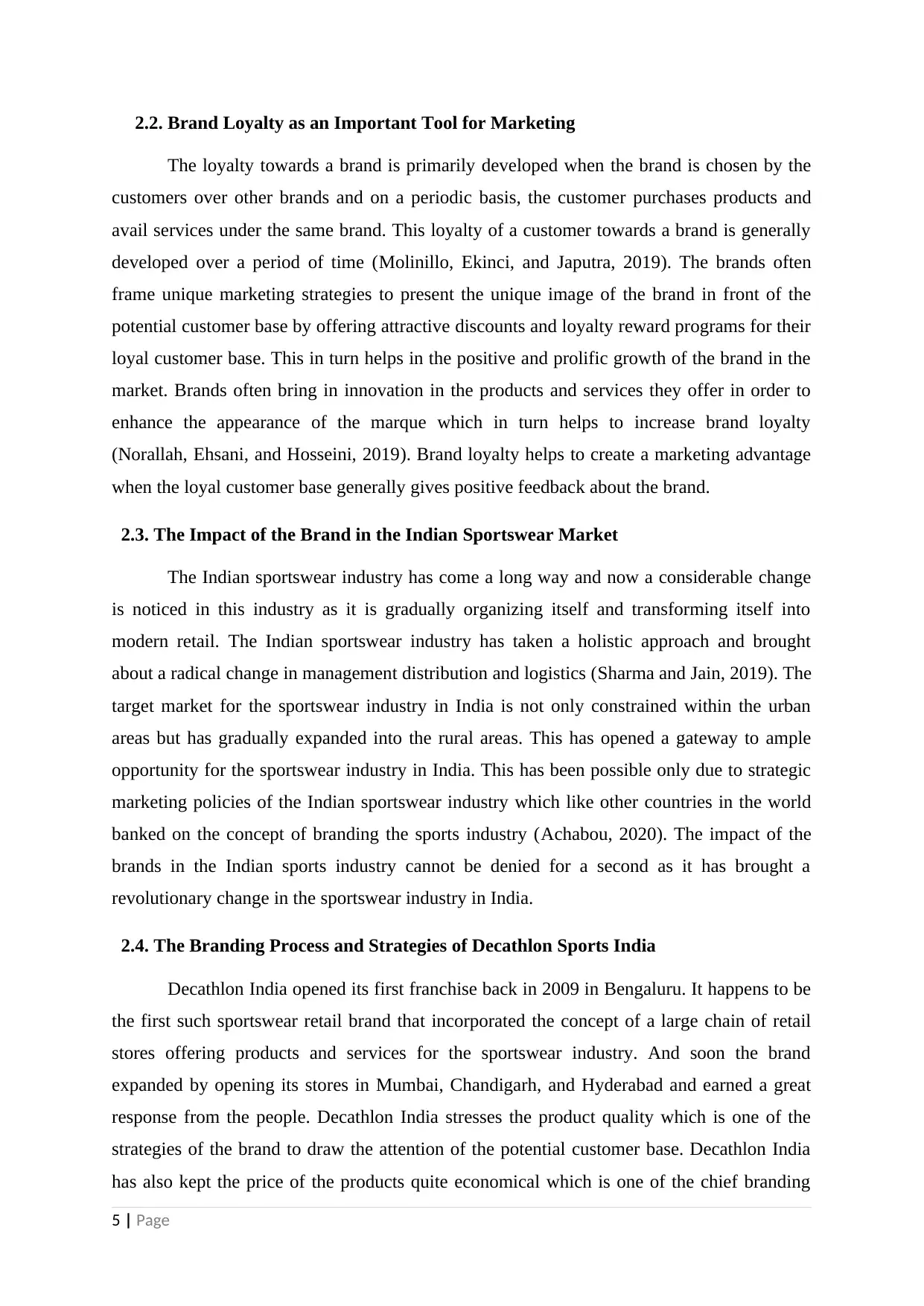
2.2. Brand Loyalty as an Important Tool for Marketing
The loyalty towards a brand is primarily developed when the brand is chosen by the
customers over other brands and on a periodic basis, the customer purchases products and
avail services under the same brand. This loyalty of a customer towards a brand is generally
developed over a period of time (Molinillo, Ekinci, and Japutra, 2019). The brands often
frame unique marketing strategies to present the unique image of the brand in front of the
potential customer base by offering attractive discounts and loyalty reward programs for their
loyal customer base. This in turn helps in the positive and prolific growth of the brand in the
market. Brands often bring in innovation in the products and services they offer in order to
enhance the appearance of the marque which in turn helps to increase brand loyalty
(Norallah, Ehsani, and Hosseini, 2019). Brand loyalty helps to create a marketing advantage
when the loyal customer base generally gives positive feedback about the brand.
2.3. The Impact of the Brand in the Indian Sportswear Market
The Indian sportswear industry has come a long way and now a considerable change
is noticed in this industry as it is gradually organizing itself and transforming itself into
modern retail. The Indian sportswear industry has taken a holistic approach and brought
about a radical change in management distribution and logistics (Sharma and Jain, 2019). The
target market for the sportswear industry in India is not only constrained within the urban
areas but has gradually expanded into the rural areas. This has opened a gateway to ample
opportunity for the sportswear industry in India. This has been possible only due to strategic
marketing policies of the Indian sportswear industry which like other countries in the world
banked on the concept of branding the sports industry (Achabou, 2020). The impact of the
brands in the Indian sports industry cannot be denied for a second as it has brought a
revolutionary change in the sportswear industry in India.
2.4. The Branding Process and Strategies of Decathlon Sports India
Decathlon India opened its first franchise back in 2009 in Bengaluru. It happens to be
the first such sportswear retail brand that incorporated the concept of a large chain of retail
stores offering products and services for the sportswear industry. And soon the brand
expanded by opening its stores in Mumbai, Chandigarh, and Hyderabad and earned a great
response from the people. Decathlon India stresses the product quality which is one of the
strategies of the brand to draw the attention of the potential customer base. Decathlon India
has also kept the price of the products quite economical which is one of the chief branding
5 | Page
The loyalty towards a brand is primarily developed when the brand is chosen by the
customers over other brands and on a periodic basis, the customer purchases products and
avail services under the same brand. This loyalty of a customer towards a brand is generally
developed over a period of time (Molinillo, Ekinci, and Japutra, 2019). The brands often
frame unique marketing strategies to present the unique image of the brand in front of the
potential customer base by offering attractive discounts and loyalty reward programs for their
loyal customer base. This in turn helps in the positive and prolific growth of the brand in the
market. Brands often bring in innovation in the products and services they offer in order to
enhance the appearance of the marque which in turn helps to increase brand loyalty
(Norallah, Ehsani, and Hosseini, 2019). Brand loyalty helps to create a marketing advantage
when the loyal customer base generally gives positive feedback about the brand.
2.3. The Impact of the Brand in the Indian Sportswear Market
The Indian sportswear industry has come a long way and now a considerable change
is noticed in this industry as it is gradually organizing itself and transforming itself into
modern retail. The Indian sportswear industry has taken a holistic approach and brought
about a radical change in management distribution and logistics (Sharma and Jain, 2019). The
target market for the sportswear industry in India is not only constrained within the urban
areas but has gradually expanded into the rural areas. This has opened a gateway to ample
opportunity for the sportswear industry in India. This has been possible only due to strategic
marketing policies of the Indian sportswear industry which like other countries in the world
banked on the concept of branding the sports industry (Achabou, 2020). The impact of the
brands in the Indian sports industry cannot be denied for a second as it has brought a
revolutionary change in the sportswear industry in India.
2.4. The Branding Process and Strategies of Decathlon Sports India
Decathlon India opened its first franchise back in 2009 in Bengaluru. It happens to be
the first such sportswear retail brand that incorporated the concept of a large chain of retail
stores offering products and services for the sportswear industry. And soon the brand
expanded by opening its stores in Mumbai, Chandigarh, and Hyderabad and earned a great
response from the people. Decathlon India stresses the product quality which is one of the
strategies of the brand to draw the attention of the potential customer base. Decathlon India
has also kept the price of the products quite economical which is one of the chief branding
5 | Page
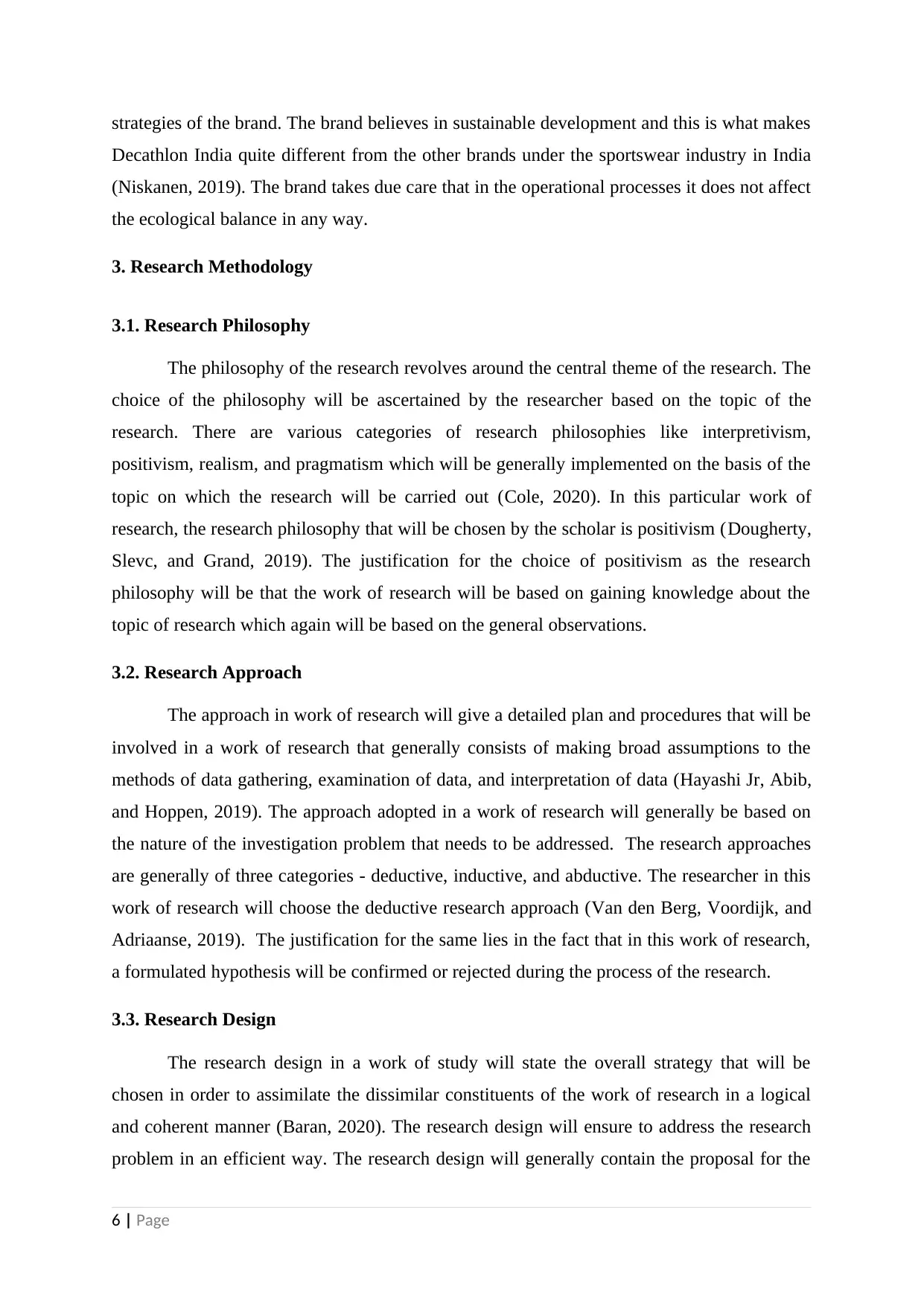
strategies of the brand. The brand believes in sustainable development and this is what makes
Decathlon India quite different from the other brands under the sportswear industry in India
(Niskanen, 2019). The brand takes due care that in the operational processes it does not affect
the ecological balance in any way.
3. Research Methodology
3.1. Research Philosophy
The philosophy of the research revolves around the central theme of the research. The
choice of the philosophy will be ascertained by the researcher based on the topic of the
research. There are various categories of research philosophies like interpretivism,
positivism, realism, and pragmatism which will be generally implemented on the basis of the
topic on which the research will be carried out (Cole, 2020). In this particular work of
research, the research philosophy that will be chosen by the scholar is positivism (Dougherty,
Slevc, and Grand, 2019). The justification for the choice of positivism as the research
philosophy will be that the work of research will be based on gaining knowledge about the
topic of research which again will be based on the general observations.
3.2. Research Approach
The approach in work of research will give a detailed plan and procedures that will be
involved in a work of research that generally consists of making broad assumptions to the
methods of data gathering, examination of data, and interpretation of data (Hayashi Jr, Abib,
and Hoppen, 2019). The approach adopted in a work of research will generally be based on
the nature of the investigation problem that needs to be addressed. The research approaches
are generally of three categories - deductive, inductive, and abductive. The researcher in this
work of research will choose the deductive research approach (Van den Berg, Voordijk, and
Adriaanse, 2019). The justification for the same lies in the fact that in this work of research,
a formulated hypothesis will be confirmed or rejected during the process of the research.
3.3. Research Design
The research design in a work of study will state the overall strategy that will be
chosen in order to assimilate the dissimilar constituents of the work of research in a logical
and coherent manner (Baran, 2020). The research design will ensure to address the research
problem in an efficient way. The research design will generally contain the proposal for the
6 | Page
Decathlon India quite different from the other brands under the sportswear industry in India
(Niskanen, 2019). The brand takes due care that in the operational processes it does not affect
the ecological balance in any way.
3. Research Methodology
3.1. Research Philosophy
The philosophy of the research revolves around the central theme of the research. The
choice of the philosophy will be ascertained by the researcher based on the topic of the
research. There are various categories of research philosophies like interpretivism,
positivism, realism, and pragmatism which will be generally implemented on the basis of the
topic on which the research will be carried out (Cole, 2020). In this particular work of
research, the research philosophy that will be chosen by the scholar is positivism (Dougherty,
Slevc, and Grand, 2019). The justification for the choice of positivism as the research
philosophy will be that the work of research will be based on gaining knowledge about the
topic of research which again will be based on the general observations.
3.2. Research Approach
The approach in work of research will give a detailed plan and procedures that will be
involved in a work of research that generally consists of making broad assumptions to the
methods of data gathering, examination of data, and interpretation of data (Hayashi Jr, Abib,
and Hoppen, 2019). The approach adopted in a work of research will generally be based on
the nature of the investigation problem that needs to be addressed. The research approaches
are generally of three categories - deductive, inductive, and abductive. The researcher in this
work of research will choose the deductive research approach (Van den Berg, Voordijk, and
Adriaanse, 2019). The justification for the same lies in the fact that in this work of research,
a formulated hypothesis will be confirmed or rejected during the process of the research.
3.3. Research Design
The research design in a work of study will state the overall strategy that will be
chosen in order to assimilate the dissimilar constituents of the work of research in a logical
and coherent manner (Baran, 2020). The research design will ensure to address the research
problem in an efficient way. The research design will generally contain the proposal for the
6 | Page
⊘ This is a preview!⊘
Do you want full access?
Subscribe today to unlock all pages.

Trusted by 1+ million students worldwide
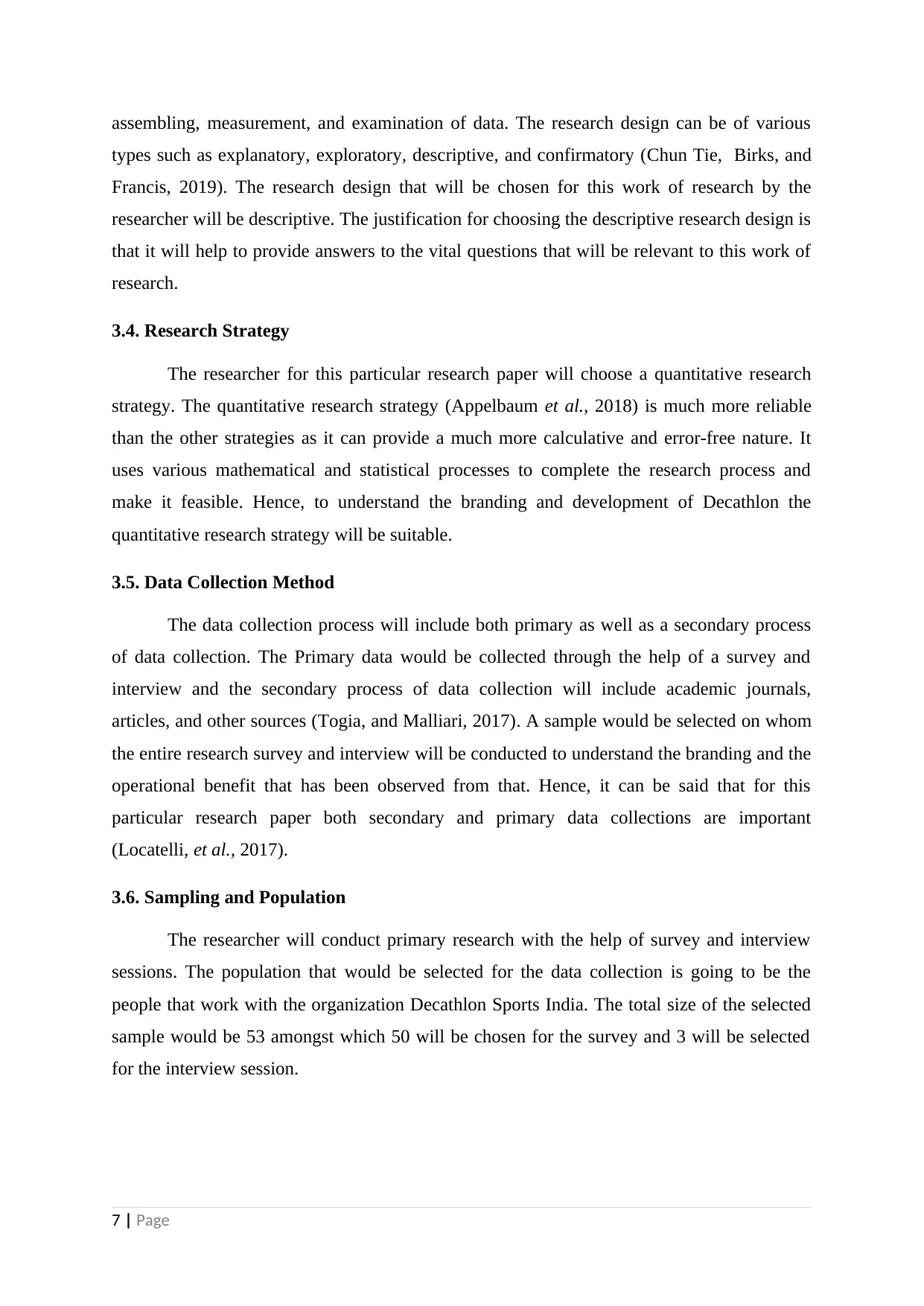
assembling, measurement, and examination of data. The research design can be of various
types such as explanatory, exploratory, descriptive, and confirmatory (Chun Tie, Birks, and
Francis, 2019). The research design that will be chosen for this work of research by the
researcher will be descriptive. The justification for choosing the descriptive research design is
that it will help to provide answers to the vital questions that will be relevant to this work of
research.
3.4. Research Strategy
The researcher for this particular research paper will choose a quantitative research
strategy. The quantitative research strategy (Appelbaum et al., 2018) is much more reliable
than the other strategies as it can provide a much more calculative and error-free nature. It
uses various mathematical and statistical processes to complete the research process and
make it feasible. Hence, to understand the branding and development of Decathlon the
quantitative research strategy will be suitable.
3.5. Data Collection Method
The data collection process will include both primary as well as a secondary process
of data collection. The Primary data would be collected through the help of a survey and
interview and the secondary process of data collection will include academic journals,
articles, and other sources (Togia, and Malliari, 2017). A sample would be selected on whom
the entire research survey and interview will be conducted to understand the branding and the
operational benefit that has been observed from that. Hence, it can be said that for this
particular research paper both secondary and primary data collections are important
(Locatelli, et al., 2017).
3.6. Sampling and Population
The researcher will conduct primary research with the help of survey and interview
sessions. The population that would be selected for the data collection is going to be the
people that work with the organization Decathlon Sports India. The total size of the selected
sample would be 53 amongst which 50 will be chosen for the survey and 3 will be selected
for the interview session.
7 | Page
types such as explanatory, exploratory, descriptive, and confirmatory (Chun Tie, Birks, and
Francis, 2019). The research design that will be chosen for this work of research by the
researcher will be descriptive. The justification for choosing the descriptive research design is
that it will help to provide answers to the vital questions that will be relevant to this work of
research.
3.4. Research Strategy
The researcher for this particular research paper will choose a quantitative research
strategy. The quantitative research strategy (Appelbaum et al., 2018) is much more reliable
than the other strategies as it can provide a much more calculative and error-free nature. It
uses various mathematical and statistical processes to complete the research process and
make it feasible. Hence, to understand the branding and development of Decathlon the
quantitative research strategy will be suitable.
3.5. Data Collection Method
The data collection process will include both primary as well as a secondary process
of data collection. The Primary data would be collected through the help of a survey and
interview and the secondary process of data collection will include academic journals,
articles, and other sources (Togia, and Malliari, 2017). A sample would be selected on whom
the entire research survey and interview will be conducted to understand the branding and the
operational benefit that has been observed from that. Hence, it can be said that for this
particular research paper both secondary and primary data collections are important
(Locatelli, et al., 2017).
3.6. Sampling and Population
The researcher will conduct primary research with the help of survey and interview
sessions. The population that would be selected for the data collection is going to be the
people that work with the organization Decathlon Sports India. The total size of the selected
sample would be 53 amongst which 50 will be chosen for the survey and 3 will be selected
for the interview session.
7 | Page
Paraphrase This Document
Need a fresh take? Get an instant paraphrase of this document with our AI Paraphraser
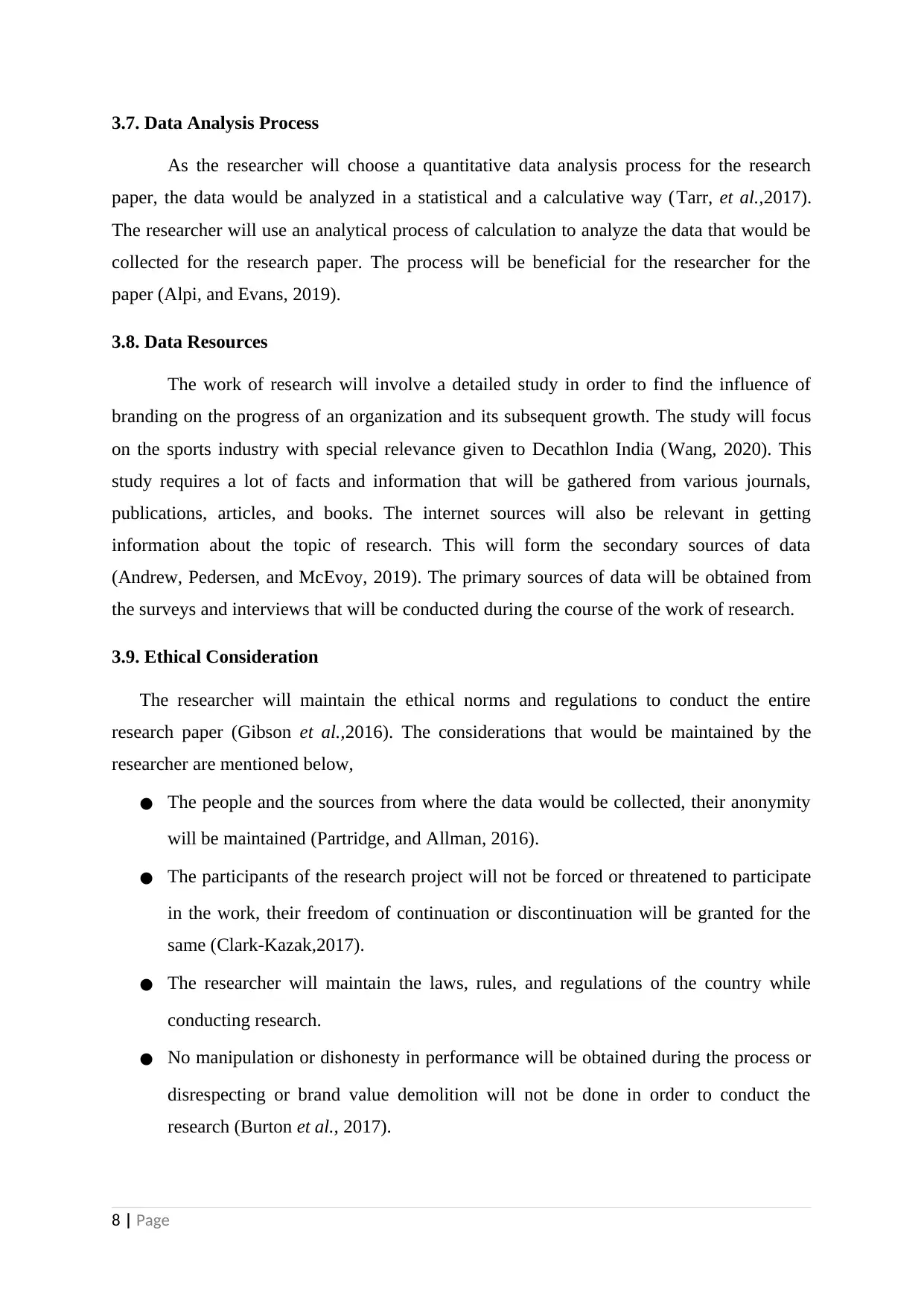
3.7. Data Analysis Process
As the researcher will choose a quantitative data analysis process for the research
paper, the data would be analyzed in a statistical and a calculative way (Tarr, et al.,2017).
The researcher will use an analytical process of calculation to analyze the data that would be
collected for the research paper. The process will be beneficial for the researcher for the
paper (Alpi, and Evans, 2019).
3.8. Data Resources
The work of research will involve a detailed study in order to find the influence of
branding on the progress of an organization and its subsequent growth. The study will focus
on the sports industry with special relevance given to Decathlon India (Wang, 2020). This
study requires a lot of facts and information that will be gathered from various journals,
publications, articles, and books. The internet sources will also be relevant in getting
information about the topic of research. This will form the secondary sources of data
(Andrew, Pedersen, and McEvoy, 2019). The primary sources of data will be obtained from
the surveys and interviews that will be conducted during the course of the work of research.
3.9. Ethical Consideration
The researcher will maintain the ethical norms and regulations to conduct the entire
research paper (Gibson et al.,2016). The considerations that would be maintained by the
researcher are mentioned below,
● The people and the sources from where the data would be collected, their anonymity
will be maintained (Partridge, and Allman, 2016).
● The participants of the research project will not be forced or threatened to participate
in the work, their freedom of continuation or discontinuation will be granted for the
same (Clark-Kazak,2017).
● The researcher will maintain the laws, rules, and regulations of the country while
conducting research.
● No manipulation or dishonesty in performance will be obtained during the process or
disrespecting or brand value demolition will not be done in order to conduct the
research (Burton et al., 2017).
8 | Page
As the researcher will choose a quantitative data analysis process for the research
paper, the data would be analyzed in a statistical and a calculative way (Tarr, et al.,2017).
The researcher will use an analytical process of calculation to analyze the data that would be
collected for the research paper. The process will be beneficial for the researcher for the
paper (Alpi, and Evans, 2019).
3.8. Data Resources
The work of research will involve a detailed study in order to find the influence of
branding on the progress of an organization and its subsequent growth. The study will focus
on the sports industry with special relevance given to Decathlon India (Wang, 2020). This
study requires a lot of facts and information that will be gathered from various journals,
publications, articles, and books. The internet sources will also be relevant in getting
information about the topic of research. This will form the secondary sources of data
(Andrew, Pedersen, and McEvoy, 2019). The primary sources of data will be obtained from
the surveys and interviews that will be conducted during the course of the work of research.
3.9. Ethical Consideration
The researcher will maintain the ethical norms and regulations to conduct the entire
research paper (Gibson et al.,2016). The considerations that would be maintained by the
researcher are mentioned below,
● The people and the sources from where the data would be collected, their anonymity
will be maintained (Partridge, and Allman, 2016).
● The participants of the research project will not be forced or threatened to participate
in the work, their freedom of continuation or discontinuation will be granted for the
same (Clark-Kazak,2017).
● The researcher will maintain the laws, rules, and regulations of the country while
conducting research.
● No manipulation or dishonesty in performance will be obtained during the process or
disrespecting or brand value demolition will not be done in order to conduct the
research (Burton et al., 2017).
8 | Page
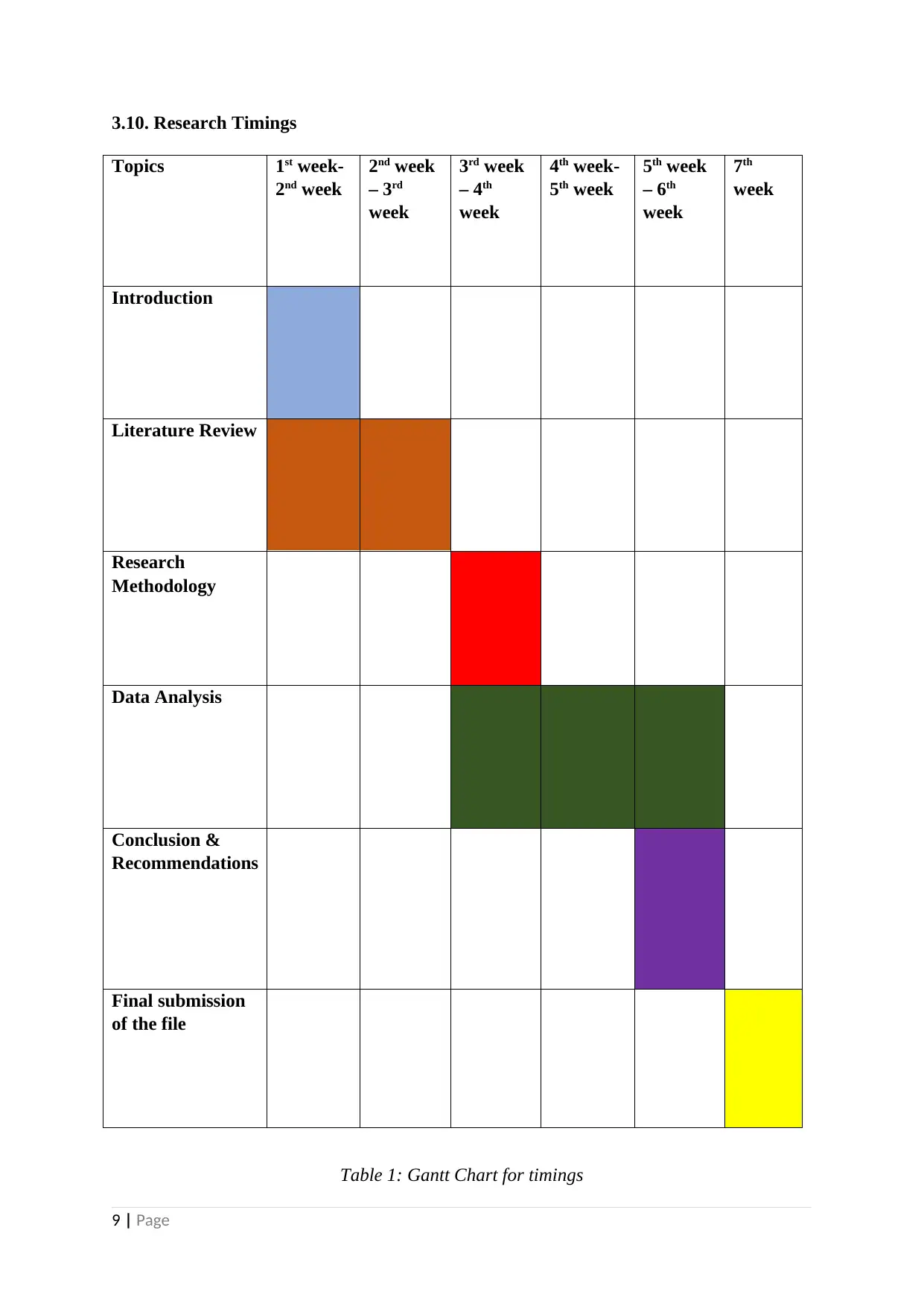
3.10. Research Timings
Topics 1st week-
2nd week
2nd week
– 3rd
week
3rd week
– 4th
week
4th week-
5th week
5th week
– 6th
week
7th
week
Introduction
Literature Review
Research
Methodology
Data Analysis
Conclusion &
Recommendations
Final submission
of the file
Table 1: Gantt Chart for timings
9 | Page
Topics 1st week-
2nd week
2nd week
– 3rd
week
3rd week
– 4th
week
4th week-
5th week
5th week
– 6th
week
7th
week
Introduction
Literature Review
Research
Methodology
Data Analysis
Conclusion &
Recommendations
Final submission
of the file
Table 1: Gantt Chart for timings
9 | Page
⊘ This is a preview!⊘
Do you want full access?
Subscribe today to unlock all pages.

Trusted by 1+ million students worldwide
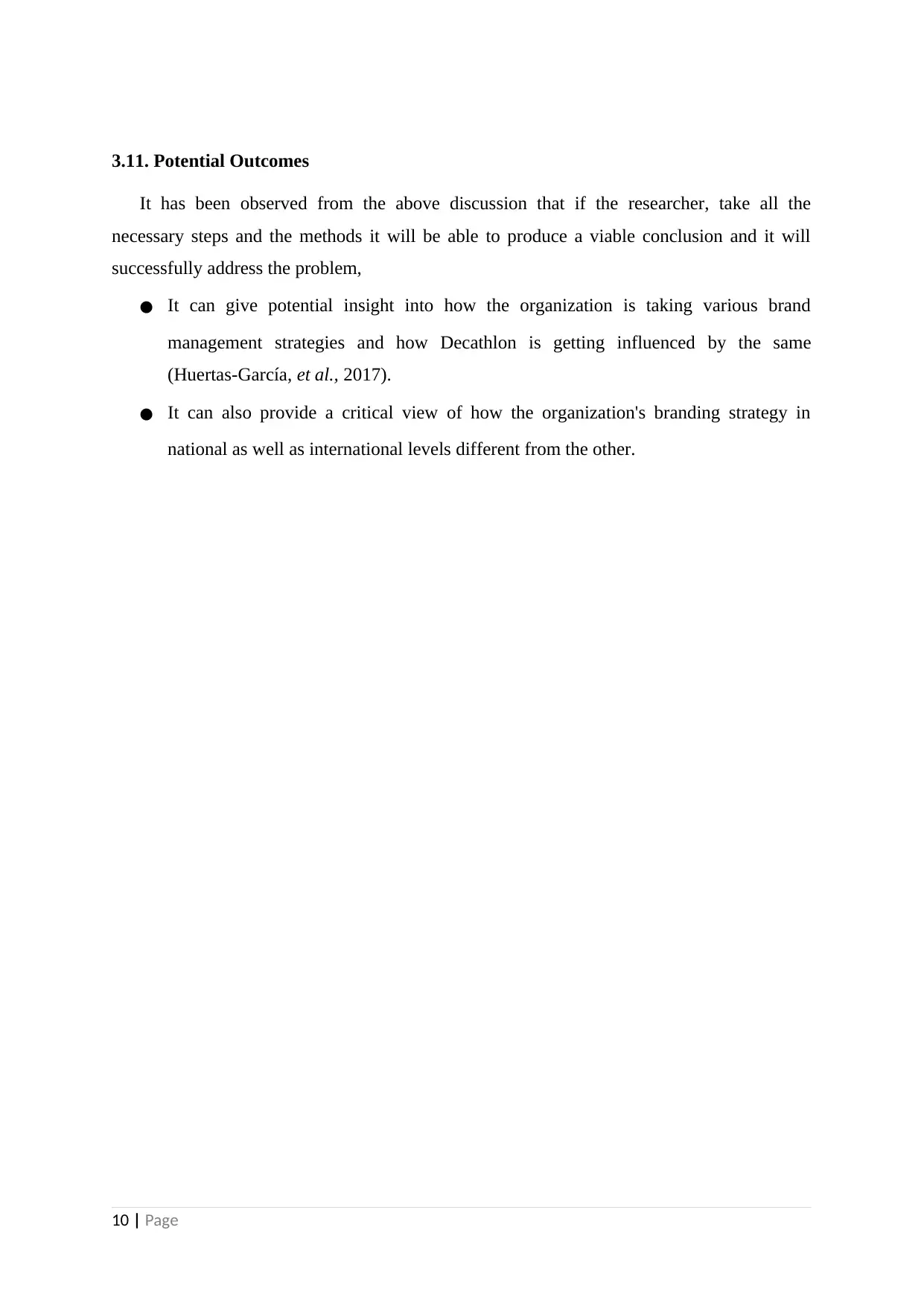
3.11. Potential Outcomes
It has been observed from the above discussion that if the researcher, take all the
necessary steps and the methods it will be able to produce a viable conclusion and it will
successfully address the problem,
● It can give potential insight into how the organization is taking various brand
management strategies and how Decathlon is getting influenced by the same
(Huertas-García, et al., 2017).
● It can also provide a critical view of how the organization's branding strategy in
national as well as international levels different from the other.
10 | Page
It has been observed from the above discussion that if the researcher, take all the
necessary steps and the methods it will be able to produce a viable conclusion and it will
successfully address the problem,
● It can give potential insight into how the organization is taking various brand
management strategies and how Decathlon is getting influenced by the same
(Huertas-García, et al., 2017).
● It can also provide a critical view of how the organization's branding strategy in
national as well as international levels different from the other.
10 | Page
Paraphrase This Document
Need a fresh take? Get an instant paraphrase of this document with our AI Paraphraser
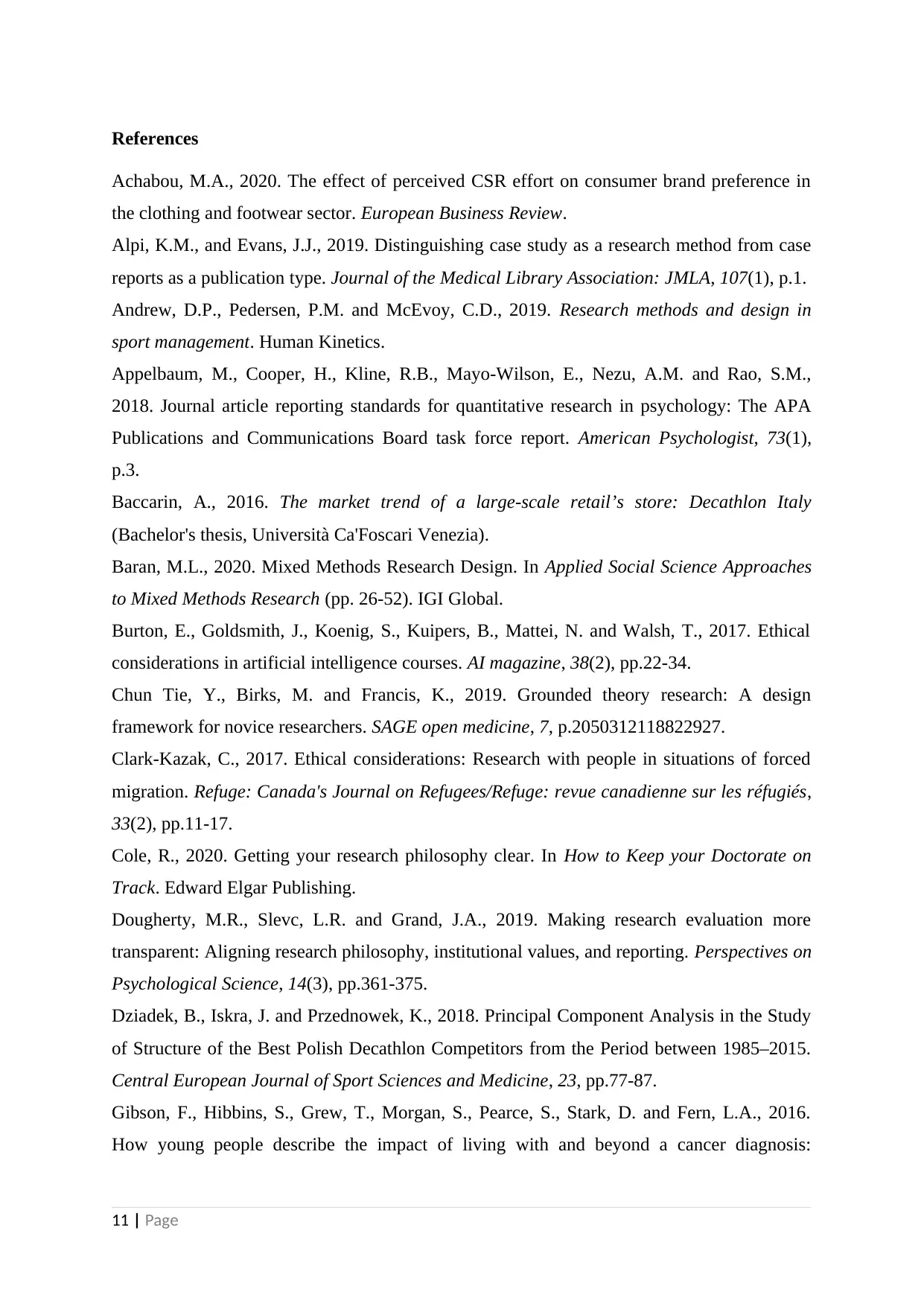
References
Achabou, M.A., 2020. The effect of perceived CSR effort on consumer brand preference in
the clothing and footwear sector. European Business Review.
Alpi, K.M., and Evans, J.J., 2019. Distinguishing case study as a research method from case
reports as a publication type. Journal of the Medical Library Association: JMLA, 107(1), p.1.
Andrew, D.P., Pedersen, P.M. and McEvoy, C.D., 2019. Research methods and design in
sport management. Human Kinetics.
Appelbaum, M., Cooper, H., Kline, R.B., Mayo-Wilson, E., Nezu, A.M. and Rao, S.M.,
2018. Journal article reporting standards for quantitative research in psychology: The APA
Publications and Communications Board task force report. American Psychologist, 73(1),
p.3.
Baccarin, A., 2016. The market trend of a large-scale retail’s store: Decathlon Italy
(Bachelor's thesis, Università Ca'Foscari Venezia).
Baran, M.L., 2020. Mixed Methods Research Design. In Applied Social Science Approaches
to Mixed Methods Research (pp. 26-52). IGI Global.
Burton, E., Goldsmith, J., Koenig, S., Kuipers, B., Mattei, N. and Walsh, T., 2017. Ethical
considerations in artificial intelligence courses. AI magazine, 38(2), pp.22-34.
Chun Tie, Y., Birks, M. and Francis, K., 2019. Grounded theory research: A design
framework for novice researchers. SAGE open medicine, 7, p.2050312118822927.
Clark-Kazak, C., 2017. Ethical considerations: Research with people in situations of forced
migration. Refuge: Canada's Journal on Refugees/Refuge: revue canadienne sur les réfugiés,
33(2), pp.11-17.
Cole, R., 2020. Getting your research philosophy clear. In How to Keep your Doctorate on
Track. Edward Elgar Publishing.
Dougherty, M.R., Slevc, L.R. and Grand, J.A., 2019. Making research evaluation more
transparent: Aligning research philosophy, institutional values, and reporting. Perspectives on
Psychological Science, 14(3), pp.361-375.
Dziadek, B., Iskra, J. and Przednowek, K., 2018. Principal Component Analysis in the Study
of Structure of the Best Polish Decathlon Competitors from the Period between 1985–2015.
Central European Journal of Sport Sciences and Medicine, 23, pp.77-87.
Gibson, F., Hibbins, S., Grew, T., Morgan, S., Pearce, S., Stark, D. and Fern, L.A., 2016.
How young people describe the impact of living with and beyond a cancer diagnosis:
11 | Page
Achabou, M.A., 2020. The effect of perceived CSR effort on consumer brand preference in
the clothing and footwear sector. European Business Review.
Alpi, K.M., and Evans, J.J., 2019. Distinguishing case study as a research method from case
reports as a publication type. Journal of the Medical Library Association: JMLA, 107(1), p.1.
Andrew, D.P., Pedersen, P.M. and McEvoy, C.D., 2019. Research methods and design in
sport management. Human Kinetics.
Appelbaum, M., Cooper, H., Kline, R.B., Mayo-Wilson, E., Nezu, A.M. and Rao, S.M.,
2018. Journal article reporting standards for quantitative research in psychology: The APA
Publications and Communications Board task force report. American Psychologist, 73(1),
p.3.
Baccarin, A., 2016. The market trend of a large-scale retail’s store: Decathlon Italy
(Bachelor's thesis, Università Ca'Foscari Venezia).
Baran, M.L., 2020. Mixed Methods Research Design. In Applied Social Science Approaches
to Mixed Methods Research (pp. 26-52). IGI Global.
Burton, E., Goldsmith, J., Koenig, S., Kuipers, B., Mattei, N. and Walsh, T., 2017. Ethical
considerations in artificial intelligence courses. AI magazine, 38(2), pp.22-34.
Chun Tie, Y., Birks, M. and Francis, K., 2019. Grounded theory research: A design
framework for novice researchers. SAGE open medicine, 7, p.2050312118822927.
Clark-Kazak, C., 2017. Ethical considerations: Research with people in situations of forced
migration. Refuge: Canada's Journal on Refugees/Refuge: revue canadienne sur les réfugiés,
33(2), pp.11-17.
Cole, R., 2020. Getting your research philosophy clear. In How to Keep your Doctorate on
Track. Edward Elgar Publishing.
Dougherty, M.R., Slevc, L.R. and Grand, J.A., 2019. Making research evaluation more
transparent: Aligning research philosophy, institutional values, and reporting. Perspectives on
Psychological Science, 14(3), pp.361-375.
Dziadek, B., Iskra, J. and Przednowek, K., 2018. Principal Component Analysis in the Study
of Structure of the Best Polish Decathlon Competitors from the Period between 1985–2015.
Central European Journal of Sport Sciences and Medicine, 23, pp.77-87.
Gibson, F., Hibbins, S., Grew, T., Morgan, S., Pearce, S., Stark, D. and Fern, L.A., 2016.
How young people describe the impact of living with and beyond a cancer diagnosis:
11 | Page
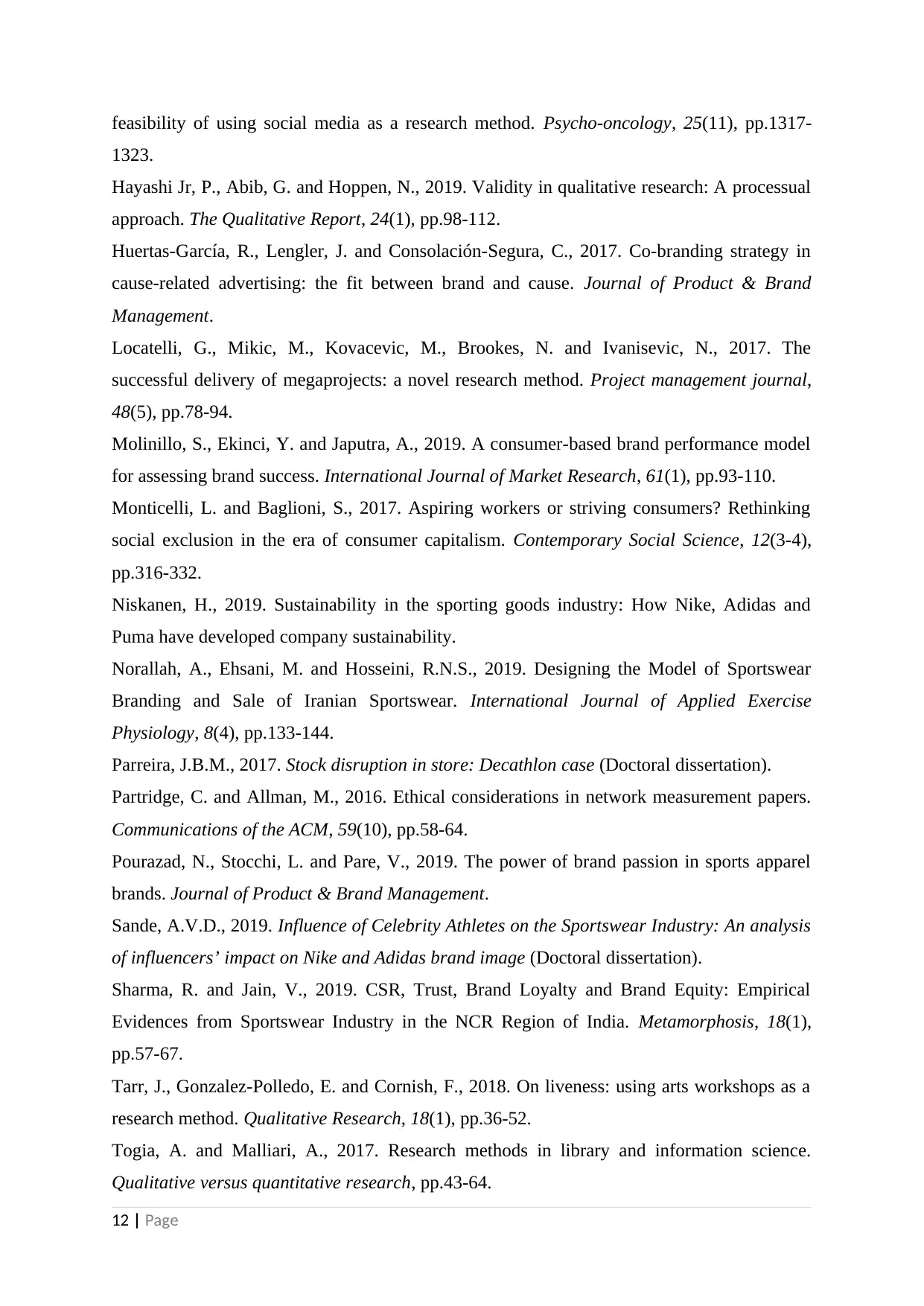
feasibility of using social media as a research method. Psycho‐oncology, 25(11), pp.1317-
1323.
Hayashi Jr, P., Abib, G. and Hoppen, N., 2019. Validity in qualitative research: A processual
approach. The Qualitative Report, 24(1), pp.98-112.
Huertas-García, R., Lengler, J. and Consolación-Segura, C., 2017. Co-branding strategy in
cause-related advertising: the fit between brand and cause. Journal of Product & Brand
Management.
Locatelli, G., Mikic, M., Kovacevic, M., Brookes, N. and Ivanisevic, N., 2017. The
successful delivery of megaprojects: a novel research method. Project management journal,
48(5), pp.78-94.
Molinillo, S., Ekinci, Y. and Japutra, A., 2019. A consumer-based brand performance model
for assessing brand success. International Journal of Market Research, 61(1), pp.93-110.
Monticelli, L. and Baglioni, S., 2017. Aspiring workers or striving consumers? Rethinking
social exclusion in the era of consumer capitalism. Contemporary Social Science, 12(3-4),
pp.316-332.
Niskanen, H., 2019. Sustainability in the sporting goods industry: How Nike, Adidas and
Puma have developed company sustainability.
Norallah, A., Ehsani, M. and Hosseini, R.N.S., 2019. Designing the Model of Sportswear
Branding and Sale of Iranian Sportswear. International Journal of Applied Exercise
Physiology, 8(4), pp.133-144.
Parreira, J.B.M., 2017. Stock disruption in store: Decathlon case (Doctoral dissertation).
Partridge, C. and Allman, M., 2016. Ethical considerations in network measurement papers.
Communications of the ACM, 59(10), pp.58-64.
Pourazad, N., Stocchi, L. and Pare, V., 2019. The power of brand passion in sports apparel
brands. Journal of Product & Brand Management.
Sande, A.V.D., 2019. Influence of Celebrity Athletes on the Sportswear Industry: An analysis
of influencers’ impact on Nike and Adidas brand image (Doctoral dissertation).
Sharma, R. and Jain, V., 2019. CSR, Trust, Brand Loyalty and Brand Equity: Empirical
Evidences from Sportswear Industry in the NCR Region of India. Metamorphosis, 18(1),
pp.57-67.
Tarr, J., Gonzalez-Polledo, E. and Cornish, F., 2018. On liveness: using arts workshops as a
research method. Qualitative Research, 18(1), pp.36-52.
Togia, A. and Malliari, A., 2017. Research methods in library and information science.
Qualitative versus quantitative research, pp.43-64.
12 | Page
1323.
Hayashi Jr, P., Abib, G. and Hoppen, N., 2019. Validity in qualitative research: A processual
approach. The Qualitative Report, 24(1), pp.98-112.
Huertas-García, R., Lengler, J. and Consolación-Segura, C., 2017. Co-branding strategy in
cause-related advertising: the fit between brand and cause. Journal of Product & Brand
Management.
Locatelli, G., Mikic, M., Kovacevic, M., Brookes, N. and Ivanisevic, N., 2017. The
successful delivery of megaprojects: a novel research method. Project management journal,
48(5), pp.78-94.
Molinillo, S., Ekinci, Y. and Japutra, A., 2019. A consumer-based brand performance model
for assessing brand success. International Journal of Market Research, 61(1), pp.93-110.
Monticelli, L. and Baglioni, S., 2017. Aspiring workers or striving consumers? Rethinking
social exclusion in the era of consumer capitalism. Contemporary Social Science, 12(3-4),
pp.316-332.
Niskanen, H., 2019. Sustainability in the sporting goods industry: How Nike, Adidas and
Puma have developed company sustainability.
Norallah, A., Ehsani, M. and Hosseini, R.N.S., 2019. Designing the Model of Sportswear
Branding and Sale of Iranian Sportswear. International Journal of Applied Exercise
Physiology, 8(4), pp.133-144.
Parreira, J.B.M., 2017. Stock disruption in store: Decathlon case (Doctoral dissertation).
Partridge, C. and Allman, M., 2016. Ethical considerations in network measurement papers.
Communications of the ACM, 59(10), pp.58-64.
Pourazad, N., Stocchi, L. and Pare, V., 2019. The power of brand passion in sports apparel
brands. Journal of Product & Brand Management.
Sande, A.V.D., 2019. Influence of Celebrity Athletes on the Sportswear Industry: An analysis
of influencers’ impact on Nike and Adidas brand image (Doctoral dissertation).
Sharma, R. and Jain, V., 2019. CSR, Trust, Brand Loyalty and Brand Equity: Empirical
Evidences from Sportswear Industry in the NCR Region of India. Metamorphosis, 18(1),
pp.57-67.
Tarr, J., Gonzalez-Polledo, E. and Cornish, F., 2018. On liveness: using arts workshops as a
research method. Qualitative Research, 18(1), pp.36-52.
Togia, A. and Malliari, A., 2017. Research methods in library and information science.
Qualitative versus quantitative research, pp.43-64.
12 | Page
⊘ This is a preview!⊘
Do you want full access?
Subscribe today to unlock all pages.

Trusted by 1+ million students worldwide
1 out of 13
Related Documents
Your All-in-One AI-Powered Toolkit for Academic Success.
+13062052269
info@desklib.com
Available 24*7 on WhatsApp / Email
![[object Object]](/_next/static/media/star-bottom.7253800d.svg)
Unlock your academic potential
Copyright © 2020–2025 A2Z Services. All Rights Reserved. Developed and managed by ZUCOL.




